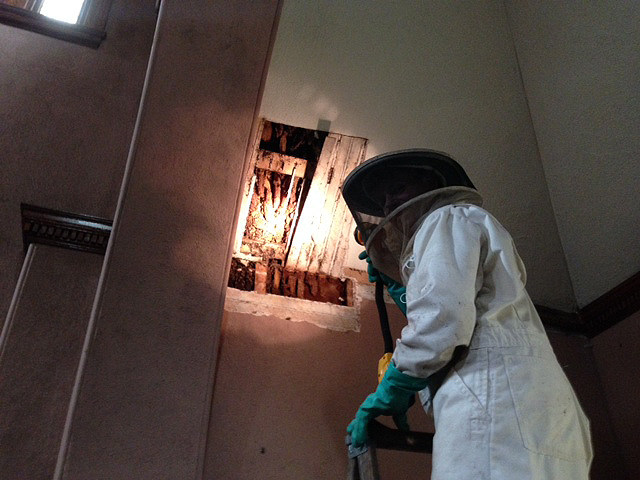Buzz off! Bees removed from area chapel
Transcribed from The Sun Chronicle, Friday, August 22, 2014
The very first “Bee Invasion” is pictured here. A swarm on the Chapel in 2002.
BY EMILY O’DONNELL – SUN CHRONICLE STAFF
MANSFIELD – There was a strong scent wafting from Card Memorial Chapel in Spring Brook Cemetery Thursday afternoon.
It wasn’t the musty smell you’d expect. Instead, the chapel smelled like a fresh bouquet with just a touch of honey, though it’s been decades since any wedding flowers adorned the little church.
The floral notes were from swarms of bees that have taken over the chapel the past few weeks.
“That’s the VOCs – volatile organic compounds” explained Jon Nelson. A Woonsocket-based bee expert and owner of B. B. Nelson Apiaries. “The fragrance of the flowers carry over into the honey. You can open a jar of honey, and within an hour the whole room smells like flowers.
“The VOCs are that incredibly floral.”
But, David Grant. A trustee of the Spring Brook Cemetery Association, said the sweet smell is not worth the troubles the bees bring.
“It has been an ongoing problem over the years,” Grant said.
He and other members of the association have attempted to remove the bee hives from the chapel without success, so Grant thought it was time to bring in Nelson to help.
Over the past week, Nelson has been gently removing the hives from inside the walls of the chapel, along with combs hanging on the outside of the building – taking care to keep the bees alive.
He drove up from Rhode Island to put the finishing touches on his work Thursday afternoon.
Nelson stepped out of his truck, followed by two stowaway bees, wearing shorts and a T-shirt – no bee suit or veil because he said they are not needed with the type of bees inside the chapel.
“These are carniolan bees. I can tell because of the color – black with honey-colored stripes – and their personalities,” he said.
Personalities?
“These bees are much calmer because they’re from Switzerland and Austria. The cooler the temperature of the location where bees originally come from, the nicer they are,” Nelson said, as a few bees buzzed about an inch from his arms, following his gestures through the air.
“With carniolan bees, I don’t even have to wear a suit. You just have to move very slowly.”
The bee expert said there were hives about 5 feet long in the ceiling of the chapel and a couple of feet down into the wall.
There were about 75,000 bees in each hive, which Nelson estimated to have been there for 50 years or more, judging from the color of the comb and the buildup of propolis, a coating bees use to sterilize their hive.
Nelson said it took him about seven hours to remove each hive because it’s such a delicate process. The beekeeper is adamant about using a process that removes bees from surfaces without killing them.
When you hear the term ‘beekeeper,’ you’d think the goal was to keep the bees,” he said.
“But, there are people out there who will tell homeowners that they’ll relocatd the bees, but instead they’ll take the honey and kill the bees. It’s absurd.”
Nelson uses a machine of his own design.
The machine uses a gentle suction to coax the bees out of the hive. They move through a vacuum hose, flying into a soft felt brush to a take a 45 degree turn into a wooden box with a screen.
Once they are inside, Nelson carefully removes the hive, honey and debris it leaves behind.
He then introduces the bees to a new comb, slowly, over the course of three days.
Nelson said if bee removal isn’t done properly, there could be real danger – more than just a couple of stings.
He said bees, if provoked, can spray venom into the air, which could cause reaction similar to the feeling of an electric shock.
It’s happened to me about four times in the 150 jobs I’ve done. The venom is a neurotoxin, and it could potentially cause anaphylactic shock if you don’t step away from the area in time,” Nelson said.
Not to mention a bungled bee removal could end up causing more problems than it solves.
If you kill bees inside the wall, other bees can still smell the leftover propolis,” he said.
“It smells like honey-baked heaven that bees can smell miles away, so other hives can move right in.”
Grant said he’s happy with the work Nelson has done, which required only a few minor cuts in the wall and roof that were easily fixed.
The 116-year old building came out smelling like a rose.
EMILY O’DONNELL CAN be reached at 508-236-0340, at eodonnell@thesunchronicle.com and on Twitter @SCMansfield.
Jon Nelson, a Woonsocket-based bee expert and owner of B. B. Nelson Apiaries suits up for the job.
The bee colony estimated to be 50 years old or more
Carniolan bee comb inside the walls of the chapel




